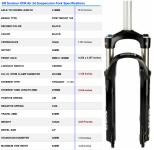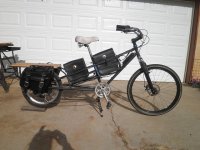LewTwo
1 MW
The length, width and depth of my ignorance has no bounds.
The Model "T" Ford used cross chassis leaf springs for its suspension.
Some early motorcycles also used leaf (or half-leaf) springs.
Some of them used parallelogram coil spring forks.
The traditional Vespa Scooter had a single sided cantilever front fork that some sources claim originated from a tri-wheel aircraft suspension.
Then there was the original Schwinn Springer fork. A number of clones exist today (mainly for the bicycle 'chopper' market) with single, dual and/or quad spring variations.
Today most Bicycle Suspension forks look to be a set of telescoping tubes on each side of the front wheel. Sometimes they extend the full length of the head tube (triple-tree) and others terminate just short of the bottom of the head tube.
What is actually enclosed in these tubes?
I would guess the simplest have some sort of mechanical coil spring and perhaps some neoprene rubber bumpers. I believe this is what 'Chalo' calls 'pogo-sticks'.
I believe that there are also hydraulic suspension forks (some combination of coil spring(s) and hydraulic shock absorber?).
What about air-over-hydraulic?
What is actually needed for paved streets (please bare in mind the poor condition of pavements in US cities these days).
When is 40 to 50mm travel adequate.
When does one need 120mm (or more) travel ?
What is a 'down hill' suspension fork'?
What is an 'inverted' fork ?
For rear suspensions, I have seen components with external gas cylinders. Do these exist for front forks as well?
Many automobiles today use nitrogen filled gas cylinders for hoods, bonnets and trunk lids rather than springs. Anything similar used for suspension forks?
Materials: Magnesium, Aluminum, Steel vs. Carbon Fiber ,.. advantages, disadvantages?
What are the best brands and why ?
The Model "T" Ford used cross chassis leaf springs for its suspension.
Some early motorcycles also used leaf (or half-leaf) springs.
Some of them used parallelogram coil spring forks.
The traditional Vespa Scooter had a single sided cantilever front fork that some sources claim originated from a tri-wheel aircraft suspension.
Then there was the original Schwinn Springer fork. A number of clones exist today (mainly for the bicycle 'chopper' market) with single, dual and/or quad spring variations.
Today most Bicycle Suspension forks look to be a set of telescoping tubes on each side of the front wheel. Sometimes they extend the full length of the head tube (triple-tree) and others terminate just short of the bottom of the head tube.
What is actually enclosed in these tubes?
I would guess the simplest have some sort of mechanical coil spring and perhaps some neoprene rubber bumpers. I believe this is what 'Chalo' calls 'pogo-sticks'.
I believe that there are also hydraulic suspension forks (some combination of coil spring(s) and hydraulic shock absorber?).
What about air-over-hydraulic?
What is actually needed for paved streets (please bare in mind the poor condition of pavements in US cities these days).
When is 40 to 50mm travel adequate.
When does one need 120mm (or more) travel ?
What is a 'down hill' suspension fork'?
What is an 'inverted' fork ?
For rear suspensions, I have seen components with external gas cylinders. Do these exist for front forks as well?
Many automobiles today use nitrogen filled gas cylinders for hoods, bonnets and trunk lids rather than springs. Anything similar used for suspension forks?
Materials: Magnesium, Aluminum, Steel vs. Carbon Fiber ,.. advantages, disadvantages?
What are the best brands and why ?









